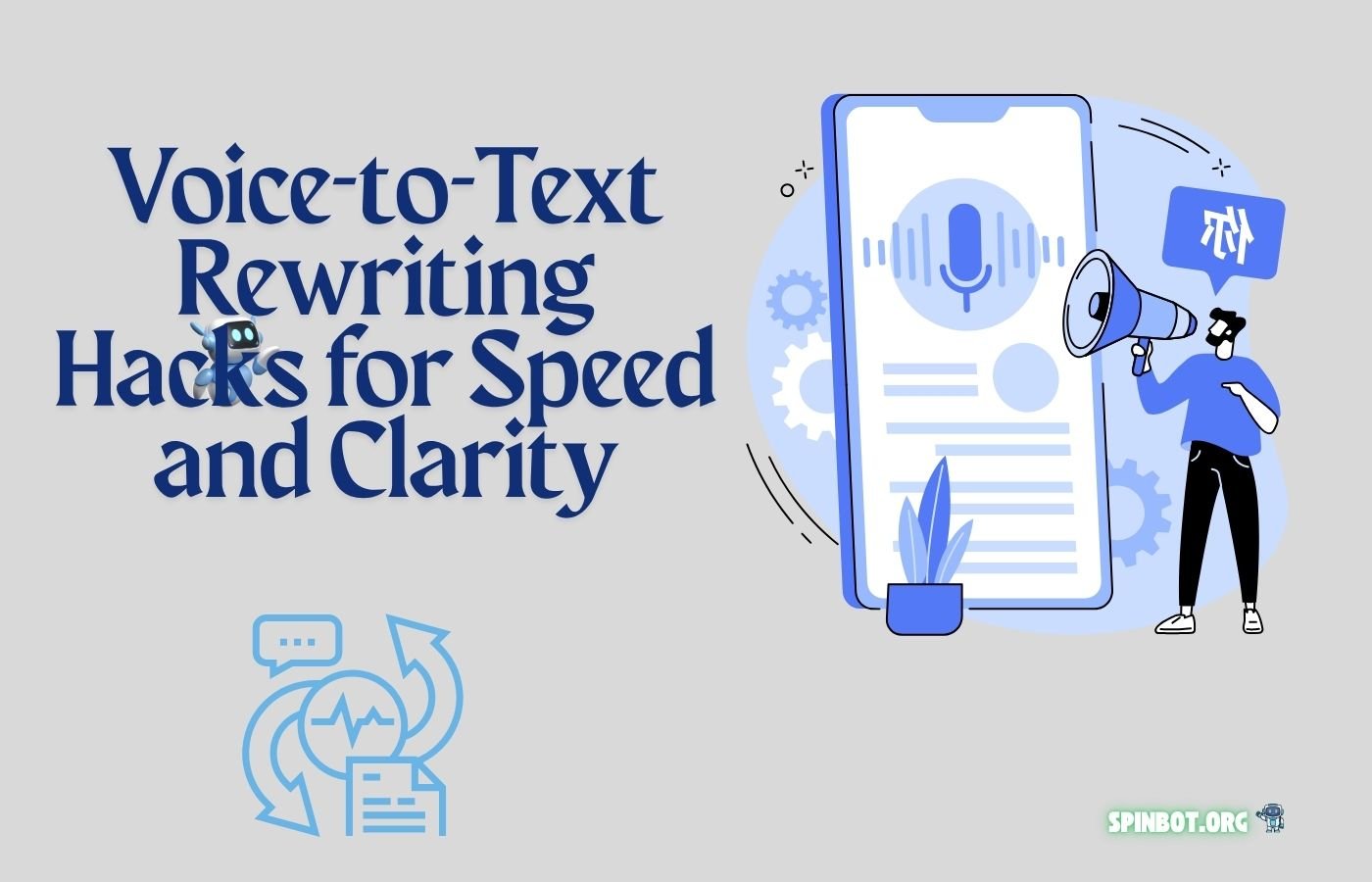Voice-to-Text Rewriting Hacks: Maximize Speed, Accuracy, and Clarity
Voice-to-text technology is a powerful way to boost your writing speed and productivity. Whether you’re a student, blogger, professional, or content creator, knowing how to rewrite voice-generated text effectively can save you hours of editing. In this article, we’ll cover proven Voice-to-Text Rewriting Hacks that help you clean, clarify, and perfect your dictations for any purpose.
What is Voice-to-Text and Why Rewriting is Crucial
Voice-to-text is the process of converting spoken words into written text using speech recognition software. It’s popular for fast note-taking, idea generation, and hands-free writing.
However, raw voice-to-text output is rarely perfect. It often contains errors, awkward phrasing, and missing punctuation. That’s why rewriting your transcribed content is essential for clarity, professionalism, and accuracy.
Common Voice-to-Text Limitations
Before diving into rewriting strategies, it’s important to understand the flaws in voice typing:
- Misinterpretation of words due to accents or pronunciation
- Lack of punctuation and grammar
- Homophones (e.g., “their” vs. “there”) errors
- Filler words like “um” or “you know”
- Awkward sentence structure
Understanding these issues helps you target your edits more efficiently.
Top Benefits of Rewriting Voice-to-Text Output
Rewriting your dictated text gives you the power to:
- Improve the logical flow of ideas
- Enhance tone and readability
- Eliminate errors and filler phrases
- Format for specific uses (e.g., blogs, essays, emails)
- Optimize content for SEO or academic clarity
Best Tools for Voice Typing
Choosing the right tool can reduce editing time and improve transcription quality. Here’s a comparison:
| Tool Name | Platform | Best Feature |
|---|---|---|
| Google Docs Voice | Web | Easy integration with Docs |
| Otter.ai | Web/iOS/Android | Smart summarization & speaker ID |
| Microsoft Dictate | Windows | Native with Office Suite |
| Apple Dictation | iOS/macOS | System-level access, fast response |
| Voice Notes | Android | Works offline, easy export options |
Voice-to-Text Rewriting Hacks (Main Section)
1. Speak in Short, Clear Phrases
Break your thoughts into short sentences. This reduces confusion and misinterpretation in transcription.
2. Use a Pre-Planned Outline
Having a structure or bullet list in mind before dictating keeps your flow organized and logical.
3. Use Voice Commands for Punctuation
Learn commands like “period,” “comma,” “new line” to insert punctuation while speaking. It cuts your editing time in half.
4. Use Editing Tools for Cleanup
Once you finish dictation, use rewriting assistants like:
- Grammarly (grammar and clarity)
- Quillbot (rewriting options)
- Hemingway App (readability)
- ChatGPT (tone polishing)
5. Proofread Using Read-Aloud Tools
Hearing your content read aloud helps identify awkward phrasing and missing words. Use tools like Natural Reader or built-in text-to-speech.
6. Batch Edit Similar Errors
Use find-and-replace to fix recurring mistakes like “its” vs. “it’s,” or “your” vs. “you’re.”
7. Use AI Rewriters Wisely
AI tools like ChatGPT can help you:
- Rewrite for tone or audience
- Convert dictation into blog format
- Shorten or expand paragraphs
8. Practice Voice Typing Regularly
Just like typing, voice input improves with practice. Speaking clearly and slowing your pace leads to better results.
Hacks for Specific Devices
Voice-to-Text Rewriting Hacks Android
- Use Gboard with voice input and editing suggestions
- Install Otter.ai for accurate recordings and easy export
- Try SpeechTexter for command-based dictation
Voice-to-Text Rewriting Hacks iOS
- Enable Apple Dictation in Settings > Keyboard
- Use Notes app for basic dictation
- Pair with Grammarly Keyboard for real-time rewriting
Voice-to-Text Rewriting Hacks Free
- Google Docs Voice Typing is free and surprisingly accurate
- Otter.ai offers a free tier with advanced options
- Combine these with free versions of Grammarly or Quillbot
How to Use Voice Typing Effectively
To get the best results:
- Speak clearly and at a moderate pace
- Minimize background noise
- Dictate in a quiet room
- Repeat unclear words to improve recognition
Want to know how do I turn on voice to text typing?
- On Android: Enable voice input in Gboard settings
- On iOS: Enable Dictation under Keyboard settings
- On desktop: Use Google Docs > Tools > Voice Typing
How to Make Google Speech to Text More Accurate
Google’s voice input can be enhanced by:
- Using a high-quality microphone
- Speaking punctuation commands
- Avoiding filler words
- Manually correcting its suggestions
- Training Google by using it often
Actionable Tips to Polish Transcribed Content
- Start with a quick read-through
- Fix the biggest issues first (grammar, missing words)
- Read aloud to check tone and flow
- Use line breaks for paragraphs when converting to blog format
- Add formatting elements like subheadings, lists, or bold text
Mistakes to Avoid
- Speaking too fast or too slow
- Relying entirely on tools for editing
- Ignoring repeated word errors
- Not adapting tone to target audience
Final Thoughts
Voice-to-text is a huge time-saver but only if you know how to clean it up properly. These Voice-to-Text Rewriting Hacks will help you turn messy transcriptions into polished, professional writing.
Whether you’re on Android, iOS, or using free tools like Google Docs Voice Typing, these strategies work universally. With clear speech, smart tools, and efficient rewriting routines, you can create better content faster.
Start using these hacks today and make your voice your superpower.

Raj blends SEO mastery with real-world freelance grit. From keyword to conversion, his expert writing helps readers and businesses win in today’s digital battlefield. Authentic. Sharp. Proven.

